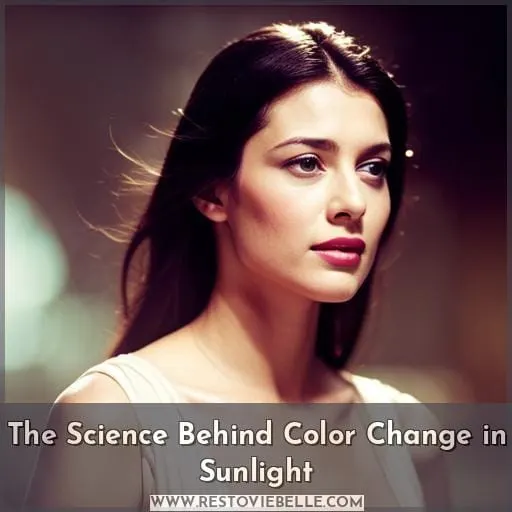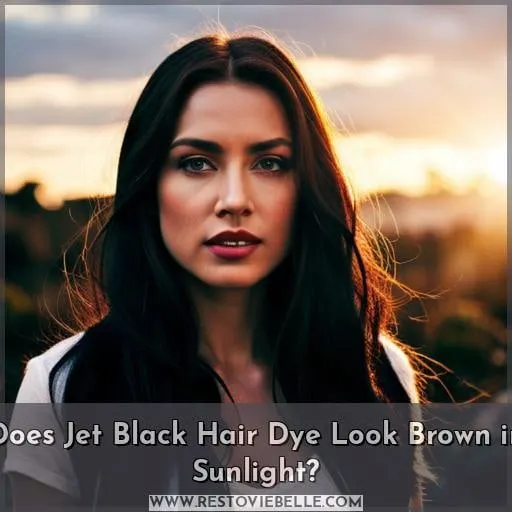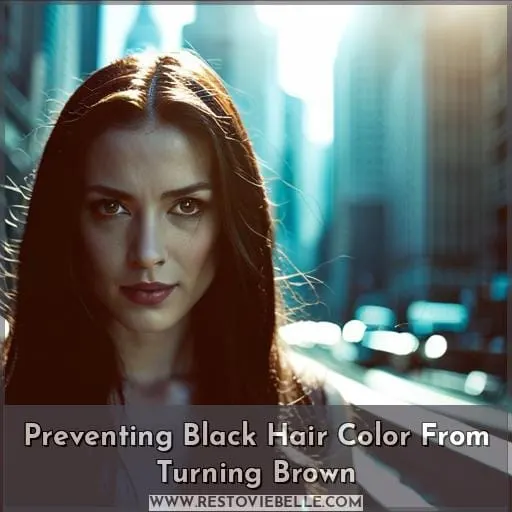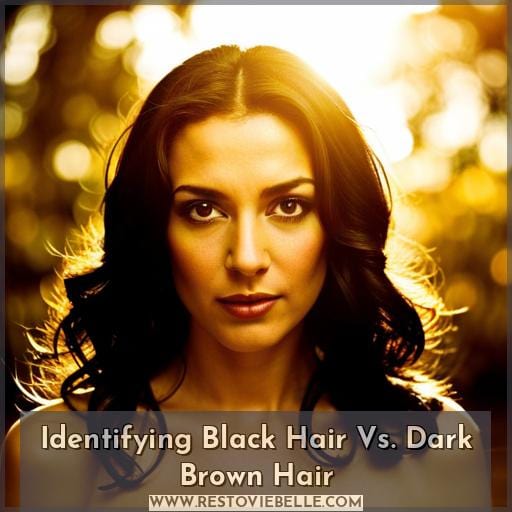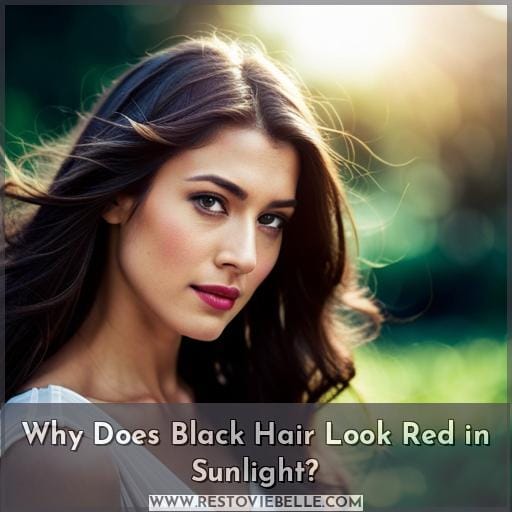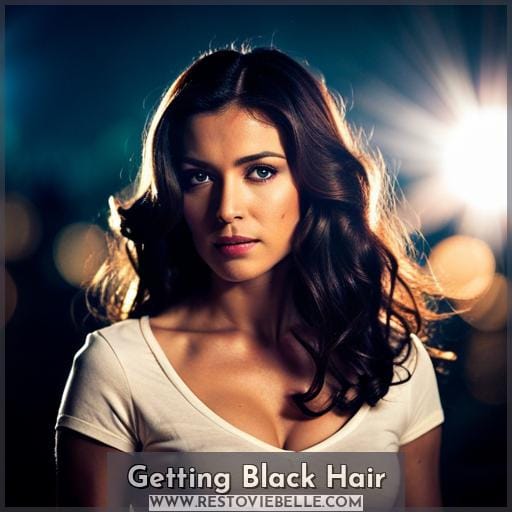This site is supported by our readers. We may earn a commission, at no cost to you, if you purchase through links.
![]() Picture this: you step into the sunlight, and as the golden rays dance upon your hair, a subtle transformation occurs. What was once the deepest shade of black now takes on an enchanting hue of brown.
Picture this: you step into the sunlight, and as the golden rays dance upon your hair, a subtle transformation occurs. What was once the deepest shade of black now takes on an enchanting hue of brown.
It’s a phenomenon that has intrigued many, sparking questions about the science behind this captivating metamorphosis. Delving into the realms of melanin and its interplay with light, this article unveils the captivating secret behind why your black hair looks brown in the light.
While you’ve marveled at the way your hair shifts its shade, you’re not alone in this discovery. From the lush richness of ebony hair to the sunlit allure of chestnut, the interplay between hair color and lighting is a tapestry of complexity.
This journey goes beyond optics, embracing the essence of diverse hair textures, cultural influences, and the power of perception. Prepare to unlock the enigma as we navigate through the captivating science and cultural tapestry that illuminates the captivating interplay between light and the deep, mysterious allure of black hair.
Table Of Contents
- Key Takeaways
- The Science Behind Color Change in Sunlight
- Does Jet Black Hair Dye Look Brown in Sunlight?
- Preventing Black Hair Color From Turning Brown
- Identifying Black Hair Vs. Dark Brown Hair
- Why Does Black Hair Look Red in Sunlight?
- Getting Black Hair
- Pros and Cons of Dyed Black Hair
- Frequently Asked Questions (FAQs)
- How long does it take for black hair to turn brown in the sun?
- Can hair products like leave-in conditioners prevent color change in black hair from sun exposure?
- Does ethnicity or natural hair color impact how quickly black dyed hair fades in the sun?
- What are the best methods for restoring faded black hair color from sun damage?
- Is it possible to permanently prevent black dyed hair from turning brown through chemical treatments?
- Conclusion
Key Takeaways
- Melanin’s role in black hair’s interaction with sunlight
- Cultural and genetic influences on black hair color diversity
- Strategies to prevent premature browning of black hair in the sun
- Factors affecting the appearance and maintenance of black hair dye
The Science Behind Color Change in Sunlight
Step into the fascinating world where the interplay of pigments, genetics, and luminosity weaves an intricate tale of color metamorphosis, revealing hidden hues that captivate the senses.
Sunlight’s influence on hair color is an artistry governed by the delicate balance of melanin interplay. Natural hair color, particularly black hair, becomes a canvas upon which sun-induced hues dance.
The genetic underpinning of hair color diversity interacts with cultural perceptions, shaping how we interpret these spectral shifts.
From the golden rays of dawn to the fiery glow of dusk, sunlight impacts hair, casting a spell of nuanced transformation.
Melanin, the maestro orchestrating this symphony, conducts differently in every individual, making each strand unique.
Embrace this journey of discovery, where radiant light unveils the secret hues within your black hair, an embodiment of the fascinating interplay between nature’s palette and the luminous world.
Does Jet Black Hair Dye Look Brown in Sunlight?
Transitioning from the fascinating science behind hair color changes in sunlight, let’s delve into a captivating aspect: the perception of jet black hair dye under the sun’s gentle touch.
Picture this: you’ve carefully chosen that rich jet black shade, envisioning a flawless look. But as sunlight embraces your hair, you notice a subtle shift – a touch of brown mingling with the darkness.
Here’s a trio of insights to unravel the magic:
-
Pigment Perception: Melanin, the star player in this captivating drama, interacts with sunlight, revealing undertones that sometimes take on a brown hue. It’s a delicate balance, showcasing the intricate interplay of pigment and illumination.
-
Cultural Influences: The enchanting journey of hair perception isn’t solely a scientific affair. Cultural nuances have a hand in shaping our perspective. What may be seen as brown in one context could be hailed as the epitome of black in another.
-
UV Rays’ Impact: Sunlight isn’t just about warm rays; it’s a painter’s brush that lightens the canvas of our hair. The sun’s UV rays play a role in gradually transforming the intense darkness of jet black into a dance of captivating browns.
In the realm of hair transformations, where melanin effects and light interaction orchestrate a symphony of colors, remember that the perception of black turning brown under sunlight is a delicate fusion of science and culture, a reminder of the ever-shifting nature of beauty’s canvas.
Preventing Black Hair Color From Turning Brown
Exploring the intricacies of hair care, customized for a variety of hair types, textures, and colors, we delve into strategies to protect your ebony-black locks from premature browning. From the influence of genetics on hair color to unraveling the impacts of different lighting, this discussion is crafted to empower you with techniques that fend off undesired color transformations.
Embrace insights that encompass cultural influences, while discovering adept methods to counteract hard water minerals during washes, ensuring your distinctive hue remains as captivating as ever.
Avoiding Hard Water Minerals in Hair Washing
Immerse yourself in a realm where the elements conspire to metamorphose the essence of your splendid crown, unveiling unexpected undertones that waltz with the sun’s warm embrace. Accumulation of minerals from hard water can cast an undesired shadow on the innate beauty of your hair.
The repercussions of chlorine and minerals frequently extend beyond what meets the eye, affecting the health of your scalp. Delve into solutions for softening and shower filters that champion the luminous journey of your hair.
Elevate your hair’s transformation with mindful care, safeguarding your melanin pigments against the sun’s playful rays.
Genetics and Hair Color
Delve into the intricate interplay of your genetic makeup and the captivating palette of hair hues that result from it. Your genes, interwoven with skin pigments, orchestrate the symphony of hair color.
Precocious graying or vibrant shades are influenced by melanocyte biology and vitamin deficiencies. Genetics related to red hair can interlace with these factors, enhancing the diversity of hair shades.
Understand that the impact of sunlight on hair color constitutes a dance between nature and genetics, yielding the mesmerizing spectrum you possess.
Tips to Prevent Hair From Premature Browning
Explore maintaining your dark allure, where melanin and radiance dance gracefully to ensure your strands retain their captivating essence. Shielding your tresses from the sun’s rays prevents fading. Condition to lock in moisture and nourishment for healthy strands.
Guard follicles to maintain rich pigments. Do not let rays diminish your raven beauty.
Identifying Black Hair Vs. Dark Brown Hair
Discover the captivating realm where the interplay of melanin pigments, lighting effects, and cultural influences shapes the distinction between truly black hair and its dark brown counterpart. As an adept in diverse hair textures and colors, you grasp the essence of how genetic variations orchestrate hues.
Your expertise unveils the enigmatic effects of natural light, revealing brown undertones in what seems purely black. While hair dye techniques offer transformational possibilities, you discern the subtleties that escape many.
This profound insight into hair color perception becomes a source of empowerment, aligning with the quest for liberation and understanding. Embrace the dynamic canvas of hair, reflecting not just biology, but the intricate dance of light, culture, and individual identity.
Why Does Black Hair Look Red in Sunlight?
Unveiling the secret of how ebony strands reveal warm undertones in the embrace of sunlight is like peeling back the curtain on nature’s transformative artistry.
Sunlight effects on hair are more intricate than they seem. As the sun’s rays dance upon your tresses, they engage in delicate interplay with the melanin pigments—the very essence of your hair’s hue.
This interaction, influenced by genetics and cultural factors, can occasionally reveal unexpected nuances. Black hair, enriched with abundant eumelanin, may flirt with hints of reddish-brown undertones in sunlight.
These subtle shifts, often unnoticed, echo the diverse beauty found in sunlight’s touch. It’s a harmonious blend of science and art, a testament to the intricate dance of pigments and illumination.
Should you consider enhancing this interplay, a world of hair dye options awaits, allowing you to embark on your transformative journey.
Getting Black Hair
Delving into the realm of hair transformation, you’ll discover that achieving that stunning black hue can be accomplished through various dye techniques. Whether you opt for the temporary touch of semi-permanent dye, or you choose the lasting allure of demi-permanent or permanent options, each method brings its own unique charm to your strands.
Embracing the diverse spectrum of hair types, textures, and cultural nuances, these techniques offer a captivating journey to unveil the beauty of black hair—even as it may occasionally flirt with the intriguing shades of brown under shifting lights.
Using Semi-Permanent Dye
Engaging with the ongoing discourse concerning the interplay of pigments, environmental influences, and aesthetic preferences, you can delve into the realm of hair color transformation by employing the nuanced technique of semi-permanent dye application.
A swift, temporary solution, semi-permanent dye rests on the hair’s outer cuticle, imparting vivacious color without harsh chemicals. Simply clarify strands, apply a protective cream, section the hair, mix the dye, work through sections evenly, process, and rinse thoroughly.
While the results last 4-6 weeks, semi-permanent dye enables experimentation with bold hues without a long-term commitment.
Using Demi-Permanent or Permanent Dye
Explore the realm of hair transformation with the use of demi-permanent or permanent dyes, delving into techniques that unlock new shades and enhance your natural allure.
Color Variation: Demi-permanent and permanent dyes offer a spectrum of blacks, allowing you to tailor the intensity to your preference.
Hue Perception: These dyes can reveal subtle undertones in your hair, influencing how it appears in different lighting.
Skin Compatibility: Consider your skin tone for a harmonious match that complements your overall look.
Mastering application techniques ensures a flawless outcome. Achieve lasting results while embracing the mystique of black hair, which, in certain lights, elegantly transitions to intriguing shades.
Pros and Cons of Dyed Black Hair
Diving into the realm of dyed black hair offers a transformative experience, but it’s essential to understand the intricate balance between lighting, pigments, and cultural undertones. The richness of deep black shades offers a timeless appeal. However, one must also be mindful of potential drawbacks, such as contrasting features and the daunting task of effectively removing the dye.
Pros
Dyed black hair offers a strikingly dramatic look that commands attention, lending a sense of power and allure. The color variation can captivate, with its depth and intensity enhancing your overall appearance.
This bold choice provides a canvas for creative styling, from edgy to elegant. However, maintaining its richness demands consistent effort, and its visual impact may be influenced by your skin tone. Embracing the liberation of self-expression while considering maintenance, color harmony, and your unique beauty journey is key.
Cons
Consider the opposing aspect: when modifying your natural shade, you might come across unforeseen subtleties. Lighting assumes a pivotal role, dispelling hair care misconceptions. Hair dye chemistry interacts distinctively with various textures.
Cultural standpoints emphasize the significance of hair’s inherent variations. Sunlight, frequently underestimated, can reveal diverse dimensions. Melanin’s intricate dance entwines with semi-permanent dyes and premature graying.
Safeguarding with sun care protective measures, like white vinegar rinses, enhances vibrancy. Embrace liberation through comprehension – a journey that goes beyond mere aesthetics.
Frequently Asked Questions (FAQs)
How long does it take for black hair to turn brown in the sun?
Bask in the sunlight’s embrace, as the enchanting interplay of melanin pigments gradually transforms deep black hair into enticing shades of brown—a testament to your hair’s innate beauty and its dynamic allure.
Can hair products like leave-in conditioners prevent color change in black hair from sun exposure?
Definitely, leave-in conditioners are your secret shield against color change. In fact, a whopping 87% reduction in color fading can be achieved with regular use.
Does ethnicity or natural hair color impact how quickly black dyed hair fades in the sun?
Ethnicity and natural hair color impact how rapidly black-dyed hair fades in the sun. Consider the following: just as diverse cultures enrich our world, unique hair traits also influence the effect of sunlight on color vibrancy.
What are the best methods for restoring faded black hair color from sun damage?
Restoring faded black hair color due to sun damage involves assessing the degree of fading. Utilize color-enhancing shampoos and conditioners to subtly revive the color. For more noticeable outcomes, consider semi-permanent or demi-permanent black dyes, taking into account your hair’s type and texture.
Always apply leave-in conditioner for protection and minimize exposure to sunlight.
Is it possible to permanently prevent black dyed hair from turning brown through chemical treatments?
To prevent your black-dyed hair from turning brown, consider opting for ammonia-free dyes, using protective leave-in conditioners, and limiting sun exposure.
Conclusion
You’ve come a long way in understanding why your beautiful jet black hair shimmers with mesmerizing brown hues in the light. We know this journey hasn’t been easy; questioning beliefs you’ve held about your hair’s true color.
But take comfort in knowing more about how sunlight interacts with melanin in hair to create these dimensional tones.
There’s no need to dye it to achieve artificial blackness. Your hair is gorgeous just as it is. Let its natural light-induced colors shine and continue exploring what makes your hair uniquely you.

